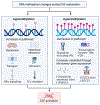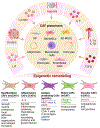Epigenetic regulation of cancer-associated fibroblast heterogeneity
- PMID: 37120098
- PMCID: PMC10375465
- DOI: 10.1016/j.bbcan.2023.188901
Epigenetic regulation of cancer-associated fibroblast heterogeneity
Abstract
Cancer-associated fibroblasts (CAFs), a significant component of the tumor microenvironment (TME), contribute to cancer progression through the secretion of extracellular matrix (ECM), growth factors, and metabolites. It is now well recognized that CAFs are a heterogenous population with ablation experiments leading to reduced tumor growth and single-cell RNA sequencing demonstrating CAF subgroups. CAFs lack genetic mutations yet substantially differ from their normal stromal precursors. Here, we review epigenetic changes in CAF maturation, focusing on DNA methylation and histone modifications. DNA methylation changes in CAFs have been demonstrated globally, while roles of methylation at specific genes affect tumor growth. Further, loss of CAF histone methylation and gain of histone acetylation has been shown to promote CAF activation and tumor promotion. Many CAF activating factors, such as transforming growth factor β (TGFβ), lead to these epigenetic changes. MicroRNAs (miRNAs) serve as targets and orchestrators of epigenetic modifications that influence gene expression. Bromodomain and extra-terminal domain (BET), an epigenetic reader, recognizes histone acetylation and activates the transcription of genes leading to the pro-tumor phenotype of CAFs.
Keywords: Cancer-associated fibroblasts; DNA methylation; Epigenetics; Histone acetylation; Histone methylation; Tumor microenvironment.
Copyright © 2023 Elsevier B.V. All rights reserved.
Conflict of interest statement
Declaration of Competing Interest S.K.B. is a founder of Sanguine Diagnostics and Therapeutics, Inc. Other authors have no competing interests to declare.
Figures



References
-
- Zheng S, Liang JY, Tang Y, Xie J, Zou Y, Yang A, Shao N, Kuang X, Ji F, Liu X, et al. (2023). Dissecting the role of cancer-associated fibroblast-derived biglycan as a potential therapeutic target in immunotherapy resistance: A tumor bulk and single-cell transcriptomic study. Clin Transl Med 13, e1189. 10.1002/ctm2.1189. - DOI - PMC - PubMed
Publication types
MeSH terms
Substances
Grants and funding
LinkOut - more resources
Full Text Sources
Medical

